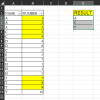You are using an out of date browser. It may not display this or other websites correctly.
You should upgrade or use an alternative browser.
You should upgrade or use an alternative browser.
Filter the names with consecutive numbers greater than or equal to 2
- Thread starter petter_hoang
- Start date
GraH - Guido
Well-Known Member
Nice challenge to test out some modern Excel functions.
However I got stuck in the let function, where I can't manage to get BYROW ( ) work.
So far:
[D3]:
=LET(_dNames;UNIQUE(data[NAME]);
_Cnt_names;COUNTIF(data[NAME];_dNames);
_min;MINIFS(data[NUMBER];data[NAME];_dNames);
_Stack;HSTACK(_dNames;_Cnt_names;_min);
_flt;FILTER(_Stack;_Cnt_names>2);
_flt)
Fills the range D3:F3 and provides me the details to create a sequence to which we can match the numbers.
[G3] (filled down): =SUM(--(SEQUENCE(;E3;F3;1)=AGGREGATE(15;6;data[NUMBER]/(data[NAME]=D3);SEQUENCE(;E3))))=E3
checks the condition that the numbers are in sequence, starting from the minimum value of number for each name. The sum of TRUEs must match
the number of times the name occurs (countif).
It is this part I cannot figure out to make it work with a BYROW/LAMBDA combo.
[I:3]: =FILTER(D3:D500;G3:G500) delivers he final result.

Looking forward to the replies of some of our formula wizards.
However I got stuck in the let function, where I can't manage to get BYROW ( ) work.
So far:
[D3]:
=LET(_dNames;UNIQUE(data[NAME]);
_Cnt_names;COUNTIF(data[NAME];_dNames);
_min;MINIFS(data[NUMBER];data[NAME];_dNames);
_Stack;HSTACK(_dNames;_Cnt_names;_min);
_flt;FILTER(_Stack;_Cnt_names>2);
_flt)
Fills the range D3:F3 and provides me the details to create a sequence to which we can match the numbers.
[G3] (filled down): =SUM(--(SEQUENCE(;E3;F3;1)=AGGREGATE(15;6;data[NUMBER]/(data[NAME]=D3);SEQUENCE(;E3))))=E3
checks the condition that the numbers are in sequence, starting from the minimum value of number for each name. The sum of TRUEs must match
the number of times the name occurs (countif).
It is this part I cannot figure out to make it work with a BYROW/LAMBDA combo.
[I:3]: =FILTER(D3:D500;G3:G500) delivers he final result.

Looking forward to the replies of some of our formula wizards.
Attachments
Attachments
shrivallabha
Excel Ninja
If you have access to UNIQUE and FILTER functions then you can try (might be CTRL+SHIFT+ENTER depending on your version of Excel):
=UNIQUE(FILTER(A3:A19,IF(A3:A19=A4:A20,IF(B3:B19>=2,IF(B3:B19=(B4:B20-1),TRUE,FALSE),FALSE),FALSE)))
=UNIQUE(FILTER(A3:A19,IF(A3:A19=A4:A20,IF(B3:B19>=2,IF(B3:B19=(B4:B20-1),TRUE,FALSE),FALSE),FALSE)))
GraH - Guido
Well-Known Member
To understand the "ins" of the formulae provided by both Ninjas, I changed 1 number in B15. Still the sequence of "H" is broken. However the title being "Filter the names with consecutive numbers greater than or equal to 2", means my futile attempt fails. 
The cunning thing in both solutions is referring to the same column range, yet offset by 1 cell (be it up or down). That's a practise that isn't in my trickery box.

The cunning thing in both solutions is referring to the same column range, yet offset by 1 cell (be it up or down). That's a practise that isn't in my trickery box.
Would A still be included if:
View attachment 81656
and how about:
View attachment 81657
and finally, would C be included in these circumstances?:
View attachment 81658
Hi p45cal,
What are Consecutive Numbers?
Numbers that follow each other continuously in the order from smallest to largest are called consecutive numbers.
For example:
1, 2, 3, 4, 5, 6, and so on are consecutive numbers.
So,
Your examples are not related to the OP's question.
Regards
Last edited:




